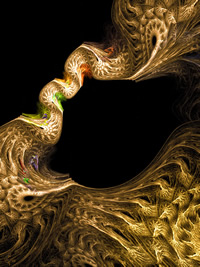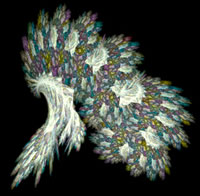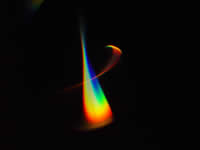5. Black
Black is the most misunderstood ‘colour’ in the range, having picked up a remarkably bad reputation over the years - mostly undeservedly
Its basic quality is to hide from sight - and therein arise most of the explanations behind its bad name. Black represents a state which is the opposite of light or white. In our world of matter, darkness occurs in a regular cycle, alternating with light, because night comes once a day, if you see what I mean. Night-time is not necessarily evil or wicked; it is simply darker than daytime.
Most of black’s reputation for evil and wickedness comes from the basic failing of humanity, I think. Darkness conceals things from view, so most evil or cruel undertakings are likely to be shaped in darkness - where no-one else can see them, or take action against them. Therefore darkness, and its representative black, have come to be associated with many of the characteristics which are worst in mankind.

Black’s greatest function is its contrast against white, or lightness. Secrecy, silence, gestation, formulation, germination, seeding and early development are all functions of darkness. The human foetus spends the first months of its life in the relative darkness of its mother’s womb (it does have to be said that people having pre-birth recall describe this as very dark blue rather than black), as do the young of animals, and even seeding plants (the womb here belongs to the earth itself).
Black maintains privacy and hides treasure from prying eyes. Much thinking and planning takes place in the semi-darkness of the human mind. New ideas are born in darkness (I bet you’ve had a few bright ideas!)
Almost all forms of spiritual initiation contain black or dark periods where the functions of the eyes are deliberately curtailed, in order to allow the inner eye to work without interruption or intrusion. Most of us need darkness in which to sleep, and we do not think it unusual to close our eyes in order to meditate.
Therefore black has a very useful and essential function both in everyday life, and in any process directed to spiritual evolution.
As you will see, black is often associated in myth and legend with the forces of death or destruction of matter, but these forces are not necessarily considered evil. We have begun to misunderstand the principle of death because we are too intimately connected with our physical bodies and with the physical world, thus placing inflated importance and significance on both.
Death, destruction and decay are natural functions of a healthy world of matter. After all, if nothing ever died and decayed back to its primary state, we would find existence on an overloaded planet quite impossible. So the connection which black has to some of the gods and goddesses of death is not a link with evil forces - it is a link to forces which break down that which has no further material value. This decays into its components, clearing the way for new growth and regeneration.
As I have said, much of our misunderstanding of the colour black comes from an original and ongoing misuse of its hiding and concealing properties. When we do something that we don’t want anybody else to see, we hide it in darkness. Therefore an association with negative qualities has grown up around black and darkness. The colour has been used to represent cruelty, lack of compassion, evil and pain. However it seems a harsh judgement of a colour if we measure it by our failings, rather than by its qualities.
Lighter and darker shades of black:
Similar to white, there is a threshold at which the tone is total. There are no darker shades of black. If it is not total, then it is penetrated by some other colour which modifies its effects accordingly. The highest form of black is quite a complicated concept to grasp. It is the state of there being no light whatsoever present... not simple opaque black, for this surface still reflects a small amount of light; but a darkness which has as one of its components space as well as the absence of light.
It is fairly unusual to experience this state in everyday life. We would normally only find it in places which totally exclude light - a photographic darkroom might approach it, or perhaps a mineshaft with no artificial illumination, or a sensory deprivation tank. Very deep caves may produce this effect too, or windowless buildings. However the experience of total darkness is quite unusual. Somehow a little light usually manages to seep in somehow. Even the examples given above are inadequate to describe total darkness, for they are all relatively enclosed spaces - and total blackness is also about emptiness, a void in which nothing at all exists.
Some of you may already have grappled with this concept in your exploration of faith and spiritual belief. If so you will know that this is a concept which stretches the human mind beyond the boundaries of reality. However, this is the best approximation of total blackness we can find - notness!

Traditional Applications of Black:
This is the colour of mourning in most of Western society, regularly used to denote death, bereavement and grief; the colour of robes worn by the clergy, in the Christian church - the reasons for this are unclear, but may be associated with black’s ability to hide from view... one sees only the man or woman of God and does not see the individual at all. It’s also possible that black is being used to symbolise the renunciation of the nun or cleric of material life; all the rescue services use black as the basic uniform colour in Britain - again perhaps to hide the person.
Symbolic associations:
Anubis, the funerary god of the Egyptian tradition was portrayed a black jackal, and his function was to guide the soul of a dead person through the labyrinth, and to the Hall of Judgement. He was therefore regarded as a guard and guide, a protector. Interestingly enough, there are many current-day cross-references to this ‘black dog’ symbol - there are several recorded instances of people being guided to safety by black dogs which appear and disappear mysteriously.
Black is the colour associated with the Saturn/Chronos combination, relating to time, and ultimately to death. There are many ‘black’ or dark Goddess archetypes too - the Black Isis; Kali, the Hindu Goddess who also has a connection with time and death; the Black Madonna, and many more.
Oriental culture associates black with the female yin aspect of creation, regarding it as the exact complementary opposite of white. Many religions use darkness or the ‘void’ motif to describe what existed before creation took place, so here we see a return to the ‘notness’ principle.
Ravens are black birds which are given considerable significance as carriers of warnings from the spiritual realms - they are as much a part of the fabric of British myth as is the Tower of London, for it is said that if the ravens which live in the Tower ever leave it, then Britain will fall. Ravens are seen as harbingers of bad news in Scandanavian culture.
Magpies are also seen as messengers between the worlds, because of their black and white plumage (hard to say which colour belongs to which world with this symbol!)
The sacrifice of black animals was thought to bring rain after drought. A black rose is thought of as a symbol of silence in some Christian monastic orders. Quabbalistically, black is associated with the Sephirah of Binah, the Great Mother, also known as Understanding. This may be because black absorbs all colours, just as understanding absorbs all experiences.
Black cats have been regarded as lucky for thousands of years - the Egyptian cat Goddess Bast, who was portrayed as a black cat, had among her functions good luck, fertility and protection. However, in Europe, during the witch-hunts, black cats were more regularly thought to be familiars of witches than any other animal.
Symbolic and traditional combinations:
Black and red has been used for maybe years to indicate sexuality - here the red relates to the earthy aliveness of sex, whilst the black indicates the appropriate level of privacy.
When nature uses black and yellow, it almost always acts as a warning. Many black and yellow insects can administer nasty stings, and numerous poisonous snakes also have this colour combination - not to mention a few non-poisonous reptiles who are cunning enough to pretend to be poisonous!
Black and green have a special significance for pagans, because the colours are taken to represent the earth nature of their gods and goddesses.
Black and white are combined to create the Oriental yin-yang symbol, as mentioned earlier. The same combination is used in some African symbolism, again to represent the perfect harmony of balanced opposites - however here black now represents the male and white the female.
Applications of black:
In general, home-decorating black is not a good colour to use as a main theme. Whilst it can operate very efficiently to set off other colours - in furniture, for instance - large expanses of black tend to have a depressant and negative effect. There is a modern tendency in interior design of creating effects based on combinations of black, grey and white. This leads to a very utilitarian overall effect. Since human beings are, largely, not utilitarian in their expectations of the home environment, this decor is likely to have a suppressive and dampening effect on the nature of those people who live in it. Black should be used very sparingly in home decoration, and not at all where there is any hint of depression or inertia in the residents.
It is, however, a very popular colour for clothing and has a good deal of value in this area. Combinations of black with other colours can express the second colour’s nature, but still maintain a certain secrecy and mystique. This is, of course, in keeping with many social occasions. For instance, you might be going to a party where you do not know many of the guests, and here you may feel nervous, but also look forward to making new friends. Black (to hide you if you’re feeling uncomfortable) worn with mid-blue, or peach, would attract friendly interest. If your intentions are more romantically inclined, then black with pink would be fitting. Black with red, as we have already said, tends to link with half-hidden sexuality. Black with white, or silver, both have ‘impact’ effects, the first being quite stark, whilst the second is more ‘glitzy’. Black with gold conveys self-contained confidence, but beware the warning sign given off by black with yellow.
Black combined with darker shades of other colours gives a slightly sombre, thoughtful impression, whilst blackness with lighter shades tends to suggest more openness and approachability. Black and true shades (the middle range of a colour which is usually striking in its clarity and brightness) always indicate strong statements, which may be influenced by the second colour. Remember black alone allows you to pass by unseen - this is sometimes useful, and sometimes not. As we move on to assess other colours we will take a look at black with each of them.

Summary:
So, that’s black - gestation, early development, a good environment to grow new ideas, a colour to hide yourself within, and from which dreams are born. This is not an evil colour, nor even necessarily a negative one. There are times in everybody’s life when they need the privacy that black offers. But, as with all other things in life, you can have too much of one thing! Black needs, like all other colours, to be used in the right situations, and in balance with other influences
